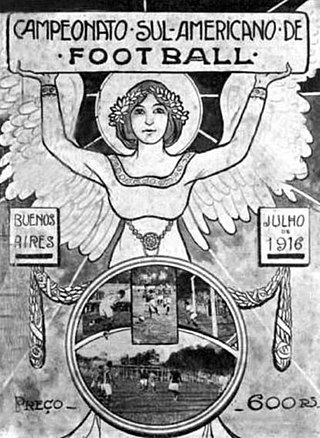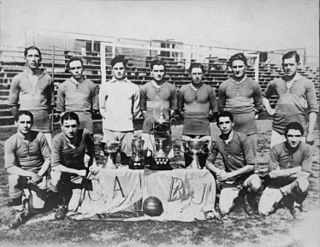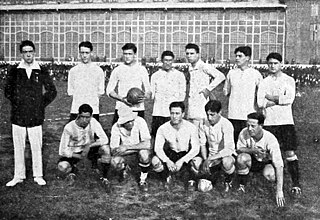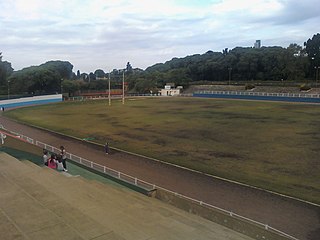
The Argentina national rugby union team represents the Argentine Rugby Union in men's international rugby union. Officially nicknamed Los Pumas, they play in sky blue and white jerseys. They are ranked 7th in the world by World Rugby, making them by some distance the highest-ranked nation in the Americas.

The 1916 South American Championship was the first continental championship for national association football teams in South America. It was held in Buenos Aires, Argentina from 2 to 17 July during Argentina's Independence Centenary commemorations. The tournament was won by Uruguay, who drew with Argentina in the last match of the tournament at Racing Club Stadium.

Rugby union in Argentina is a hugely popular team sport. The first rugby match played in the country dates back to 1873, as the game was introduced by the British. The Argentina national team, sometimes referred to as the Pumas, have competed at the Rugby World Cup, and are considered a tier one nation by the sport's governing body, World Rugby.

Club de Gimnasia y Esgrima is an Argentine multi-sports club placed in the city of Buenos Aires. The institution is one of the oldest in the country, having been established in 1880. Gimnasia y Esgrima is also one of the largest clubs of Argentina, with around 30 different disciplines hosted in the three buildings that the institution owns in Buenos Aires.

The Rosario Rugby Union is the organisational body that controls the game of rugby union in Rosario, in the province of Santa Fe, Argentina. The rest of Santa Fe province teams are organised under the Unión Santafesina de Rugby.

The Estadio Racing Club, popularly known as Estadio Alsina y Colón, was an association football stadium in Avellaneda, a suburb of Greater Buenos Aires, Argentina.
The 1936 British Lions tour of Argentina was a series of rugby union matches arranged between the British Lions and various Argentine teams. The tourists played ten matches, nine of which were against club and combined teams while one match took in a full Argentina national team. Despite being sanctioned by the International Rugby Board, no caps were awarded to players from either side.
Club Pucará is an Argentine sports club based in the Burzaco district of Greater Buenos Aires. Pucará is mostly known for its rugby union and women's field hockey teams. Other activities hosted by the club are gymnastics and swimming.

Florencia Martina Habif is an Argentine field hockey player. Being part of Argentina's Junior National Team "Las Leoncitas" since 2009 and of the National Team Las Leonas since 2010, she competed in several tournaments, including the 2012 Summer Olympics in London, where the team achieved the silver medal, being the team's youngest player. In 2014, she was named the Best Young Player in the world by the International Hockey Federation and has been nomitaded 4 times.
The 1948 Oxford-Cambridge rugby union tour of Argentina was a series of matches played in Argentina by a mixed selection of players from Oxford and Cambridge universities in 1948. The matches were held in Buenos Aires and Rosario.

The History of the Argentina national rugby union team starts with the first international played by an Argentine side against the British Isles in 1910 when they toured on South America. Argentina gained recognition in 1965, when the team toured South Africa playing a series of friendly matches there. In that tour the national team was nicknamed Los Pumas, a name that became an identity mark for Argentina, remaining to present days.

The Sociedad Sportiva Argentina was an Argentine multi-sports club sited in Buenos Aires. The headquarters were located in Florida street nº 183 while the stadium was sited in Palermo, next to Hipódromo Argentino. Originally established in 1899 under the name "Sociedad Hípica Argentina" for the practise of equestrian activities, the Sociedad Sportiva would held a large variety of sport events in several disciplines, such as football, athletics, auto racing, aviation, aerostatics, aeronautics, boxing, bicycle racing, motorcycle racing, polo, rugby union, trot, sulky races, show jumping, among others.

Plaza Jewell is the name given to Club Atlético del Rosario headquarters and sports ground. It is located in the city of Rosario in Argentina, close to Mariano Moreno bus station and Rosario Norte railway station.

The 1919 Copa de Competencia Jockey Club was the final that decided the champion of the 13° edition of this National cup of Argentina. In the match, held in Gimnasia y Esgrima de Buenos Aires on January 18, 1920, Boca Juniors defeated Rosario Central 1–0 after extra time.

The 1915 Copa de Honor Municipalidad de Buenos Aires was the final that decided the champion of the 10th. edition of this National cup of Argentina. In the match, held in Racing Club Stadium in Avellaneda, Racing Club beat Tiro Federal 2–1, winning its third consecutive Copa de Honor trophy.

The 1910 Tie Cup Final was the final match to decide the winner of the Tie Cup, the 11th. edition of the international competition organised by the Argentine and Uruguayan Football Associations. The final was contested by Argentine C.A. Estudiantes and Uruguayan CURCC. It was the last Tie Cup played by the CURCC before the club dissolved in 1915.

Juan Francia was an Argentine footballer, who played as centre forward and left winger. Due to his slim body and great agility, he eventually received the nickname Mono ("Monkey"). Francia's career include tenures on the most renowned clubs of Rosario, such as Tiro Federal, Newell's Old Boys, Rosario Central, and Provincial. He 6 titles with Rosario Central and 3 with Newell's Old Boys.

The 1920 Copa de Competencia Final was the final that decided the champion of the first edition of this national cup of Argentina, organised by dissident body Asociación Amateurs de Football.
The 1918 Copa de Honor Municipalidad de Buenos Aires Final was a football match that decided the champion of the 13th. edition of this National cup of Argentina. In the match, held in Estadio G.E.B.A. in Buenos Aires, Independiente defeated Platense 1–0. winning its first Copa de Honor trophy.

The Estadio GEBA is a multi-use stadium in the Palermo neighbourhood in Buenos Aires, Argentina. Owned by Club Gimnasia y Esgrima, the stadium is located on the "Sede Jorge Newbery", one of the three facilities of the club. Its current capacity is 12,133 spectators.






















